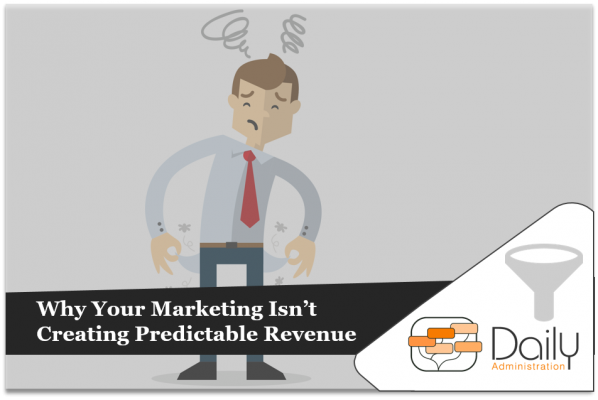Why Your Marketing Isn’t Creating Predictable Revenue

Creating Predictable Revenue with your marketing is a challenge faced by many who are focusing on marketing online.
In an effort to tackle your marketing heads on, you may be participating in marketing webinars and dabbling in a lot of techniques to establish yourself.
The problem is, you feel like you are only scratching the surface with the information that is being shared.
Additionally you are finding it hard to dig deeper to connect the dots and create the impact you need.
Essentially you may be taking one bite out of twenty five apples.
Which leaves you full but… not one of the apples are completely eaten.
You need to finish an entire apple.
The marketing information you are finding may be great.
However, the real concern is not enough revenue from your marketing efforts.
When you have invested your time, energy and resources just to come up short it can be disappointing.
Whether it be from lack of a solid plan or overlooking key conversion techniques, these oversights make a big impact when you need to generate profits.
You may be overlooking the necessary steps to convert your efforts into actual revenue.
Needless to say, in order to create predictable revenue you need to avoid these missteps.
Let’s go back to the basics to ensure you have the best foundation in place and highlight some mistakes to avoid.
Below are some common mistakes that may be preventing you from generating the revenue you need.
1. Not identifying your ideal client persona when planning your strategy
Buyer personas are powerful elements in any marketing plan and you cannot leave them out.
A Persona at a glance might seem a bit silly, but it’s extremely important to hone in on who may be the most ideal for your solutions.
Keep in mind that it is not about creating a bunch of data and statistics about your target customers to predict their next move.
You can use this information to determine common actions that actually generated revenue.
As you are putting together the commonalities of these actions, an actual “person type” that will emerge.
This “person type” is your persona of a potential client.
Giving this persona a name and a face helps to transform data and statistics into a image that you can relate to.
You next step is to then optimize your marketing plan to support these actions.
Your customers’ data and persona is definitely useful but it’s hardly enough to help you setup a solid marketing campaign with predictable revenue.
Let’s keep going…
2. Planning for brand awareness and not revenue
Brand awareness is very important for any business, but at the end of the day you want your business to be profitable not just popular.
Therefore, profitability should be your main goal when setting up a marketing campaign.
Often, marketing campaigns are set up to revolve around creating brand awareness only.
The focus is on logo, the company name, and what makes you different.
I call this “public service announcement marketing”.
You may have experienced this when you see a brand name that pops up but you don’t know what kind of solution it represents.
For larger brands like Nike, displaying a logo even if it doesn’t show a picture of a pair of shoes or athletic equipment, you still know what they’re selling.
However, for a new brand or small business, working on brand awareness alone is simply not enough.
You need to connect with your potential clients and bridge their needs to your solutions.
By presenting your solutions as a logical next step, you will lay the stepping stones that will give you the ability to create predicable revenue.
3. Results are not being measured or refined
Periodic evaluation is key to the success of any marketing plan.
By evaluating your strategy from time to time you can quickly determine what is not working and where to focus your efforts.
This is why setting measurable goals out of the gate is important to determine if you are on track later on.
But, simply measuring your results is not enough, you also have to make improvements based the results of your review.
You should have short term goals and long term goals set up.
Your short term goals will help you predict long range outcomes.
Monitoring these metrics regularly to reveal achievements and shortfalls will help you make your next move.
If you haven’t reached your goals within a particular time frame, then you may need to refine a step in your strategy.
Remember, every time you make a refinement in your strategy you may also need update your goals to make sure you stay on track.
4. Salesy content
Valuable content is a vital element in any marketing plan.
Through your content, you can improve:
- brand awareness,
- build stronger relationships with your current and potential customers and
- generate sales.
But… because you may be focused on generating revenue, you may be trying too hard to make sales through your content.
As a result, your content may be too salesy and you don’t even know it.
This kind of content doesn’t offer any value to your potential clients.
You may be investing in traffic generation to bring ideal prospects to your site but when they get there instead of getting useful information for their research, they are getting a sales pitch which is off putting.
Your content should;
- Focus on addressing the needs of your potential customers.
- Provide answers to their questions, as well as
- Share valuable and relevant information to help them become an informed buyer.
Good quality content can help you build relationships with your potential customers.
As you offer solutions to their problems, their trust around what you provide also builds.
You will be seen as a problem solver and an authoritative source for them to get relevant information.
Converting this audience into actual clients can been seen as a natural next step.
And, finally…
5. Your endless to-do list has nothing to do with your marketing strategy
Finally, and surprising to some, your to-do list is not a marketing plan.
Yes, you may have a list of marketing tasks but creating a strategy that clearly directs the flow of your marketing efforts is a different bird.
A to-do list is just that, a list containing what things to do and by when.
There is no evaluation of results. Your to-do success is only measured by how well or quickly you complete all the tasks on your list.
The goal of a to-do list is to just to complete all the tasks.
A marketing plan on the other hand, should be comprise a well-structured strategy with measurable goals that you can evaluate.
It does not need to be extremely complicated but it does need to have a purpose if you expect to generate predictable revenue.
Once you create your plan that include a strategy for generating revenue you can then craft your to-do list of the tasks needed to make your strategy successful.
By focusing on the basics and building your marketing foundation you can do more than just scratch the surface with your marketing.
You can connect the dots and generate predictable revenue.


